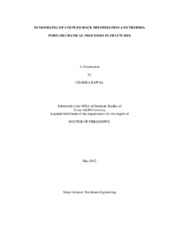| dc.description.abstract | Problems involving coupled thermo-poro-chemo-mechanical processes are of great importance in geothermal and petroleum reservoir systems. In particular, economic power production from enhanced geothermal systems, effective water-flooding of petroleum reservoirs, and stimulation of gas shale reservoirs are significantly influenced by coupled processes. During such procedures, stress state in the reservoir is changed due to variation in pore fluid pressure and temperature. This can cause deformation and failure of weak planes of the formation with creation of new fractures, which impacts reservoir response. Incorporation of geomechanical factor into engineering analyses using fully coupled geomechanics-reservoir flow modeling exhibits computational challenges and numerical difficulties. In this study, we develop and apply efficient numerical models to solve 3D injection/extraction geomechanics problems formulated within the framework of thermo-poro-mechanical theory with reactive flow.
The models rely on combining Displacement Discontinuity (DD) Boundary Element Method (BEM) and Finite Element Method (FEM) to solve the governing equations of thermo-poro-mechanical processes involving fracture/reservoir matrix. The integration of BEM and FEM is accomplished through direct and iterative procedures. In each case, the numerical algorithms are tested against a series of analytical solutions.
3D study of fluid injection and extraction into the geothermal reservoir illustrates that thermo-poro-mechanical processes change fracture aperture (fracture conductivity) significantly and influence the fluid flow. Simulations that consider joint stiffness heterogeneity show development of non-uniform flow paths within the crack. Undersaturated fluid injection causes large silica mass dissolution and increases fracture aperture while supersaturated fluid causes mineral precipitation and closes fracture aperture. Results show that for common reservoir and injection conditions, the impact of fully developed thermoelastic effect on fracture aperture tend to be greater compare to that of poroelastic effect.
Poroelastic study of hydraulic fracturing demonstrates that large pore pressure increase especially during multiple hydraulic fracture creation causes effective tensile stress at the fracture surface and shear failure around the main fracture. Finally, a hybrid BEFEM model is developed to analyze stress redistribution in the overburden and within the reservoir during fluid injection and production. Numerical results show that fluid injection leads to reservoir dilation and induces vertical deformation, particularly near the injection well. However, fluid withdrawal causes reservoir to compact. The Mandel-Cryer effect is also successfully captured in numerical simulations, i.e., pore pressure increase/decrease is non-monotonic with a short time values that are above/below the background pore pressure. | en |


